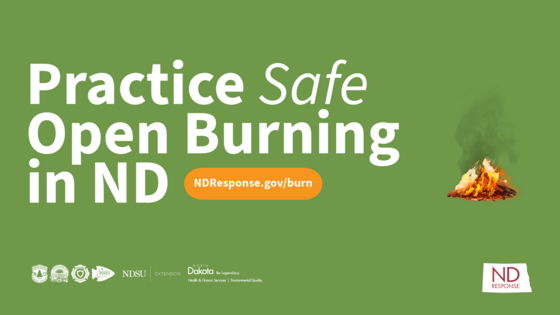Open Burning Guidance Information
The LaMoure County Fire Emergency and Burn Restrictions have been rescinded.
The interactive map updated by the North Dakota Department of Emergency Services - ND Fire Declarations & Burn Restrictions displays current fire danger and county burn restrictions across the state.
Residents should always review all information prior to burning including knowing local city ordinances, the fire danger and any burn restrictions. Residents that conduct Open Burning when not restricted should call North Dakota State Radio at 701-328-9921 to report the location, time and contact information.
This link provides information on Open Burning: https://deq.nd.gov/AQ/permitting/OpenBurning.aspx
Local city ordinances can be found on their webpages or contact the respective fire chief.
Fire Danger Ratings and Burn Restrictions, In Depth
The Fire Danger Ratings are calculated using inputs such as long-term climate information; short-term weather patterns; and indicators like relative humidity, temperature, wind speed, and fuel conditions on the ground (how dry the grasses are, for example). Weather information inputs to the Fire Danger Ratings are provided by the National Weather Service, while fuel conditions are based on a variety of inputs and modeling.
The ratings are low, moderate, high, very high, and extreme. Additionally, there are fire weather watches and red flag warnings that can be issued for heightened public awareness of critical fire weather conditions.
The fire danger ratings are indicative of the threat of fire growth, not necessarily the threat of fire starts. Should a fire ignite, it is more likely that it will spread rapidly during higher fire danger rating days.
Next, jurisdictions may put forth a Fire Emergency Declaration. These are similar to any emergency declaration and are issued by the appropriate authority such as a mayor, council, or governor. Usually, this is done to allow access to special emergency funds for response activities. These declarations can also serve to heighten public awareness of the threat. Fire Emergency are necessary to have in place in order to enforce Burn Restrictions.
Finally, Burn Restrictions are legal restrictions on outdoor fire activities that are usually tied to Counties, tribes, state, federal land management agencies, and even some cities can decide what restrictions should be in place for each level of the fire danger ratings.
Restrictions may change throughout the day so always check right before you intend to burn.
*The Fire Danger Rating System is very sensitive to inputs, so it is always best to use your judgment when determining if burning is right for you, even if it is allowed in your jurisdiction. Experts across disciplines continue to refine the fire danger rating system for increased accuracy and public safety.
Open Burning and Burn Variances, In Depth
Generally, anytime you light a fire outdoors, you are open burning. Open burning is regulated under the North Dakota Air Pollution Control Rules for the health and wellbeing of ourselves and our neighbors.
Many types of open burning such as prescribed burns, landfills, and oil, require an approved open burn variance.
Certain common activities, such as campfires, outdoor cooking fires, and agricultural crop burning do not require a burn variance.
Details are available at DEQ.nd.gov. Burn variance applications can be found at DEQ.nd.gov and must be approved by the DEQ or by district health units with variance issuing authority. Contact the DEQ or your local fire district if you have any questions.

